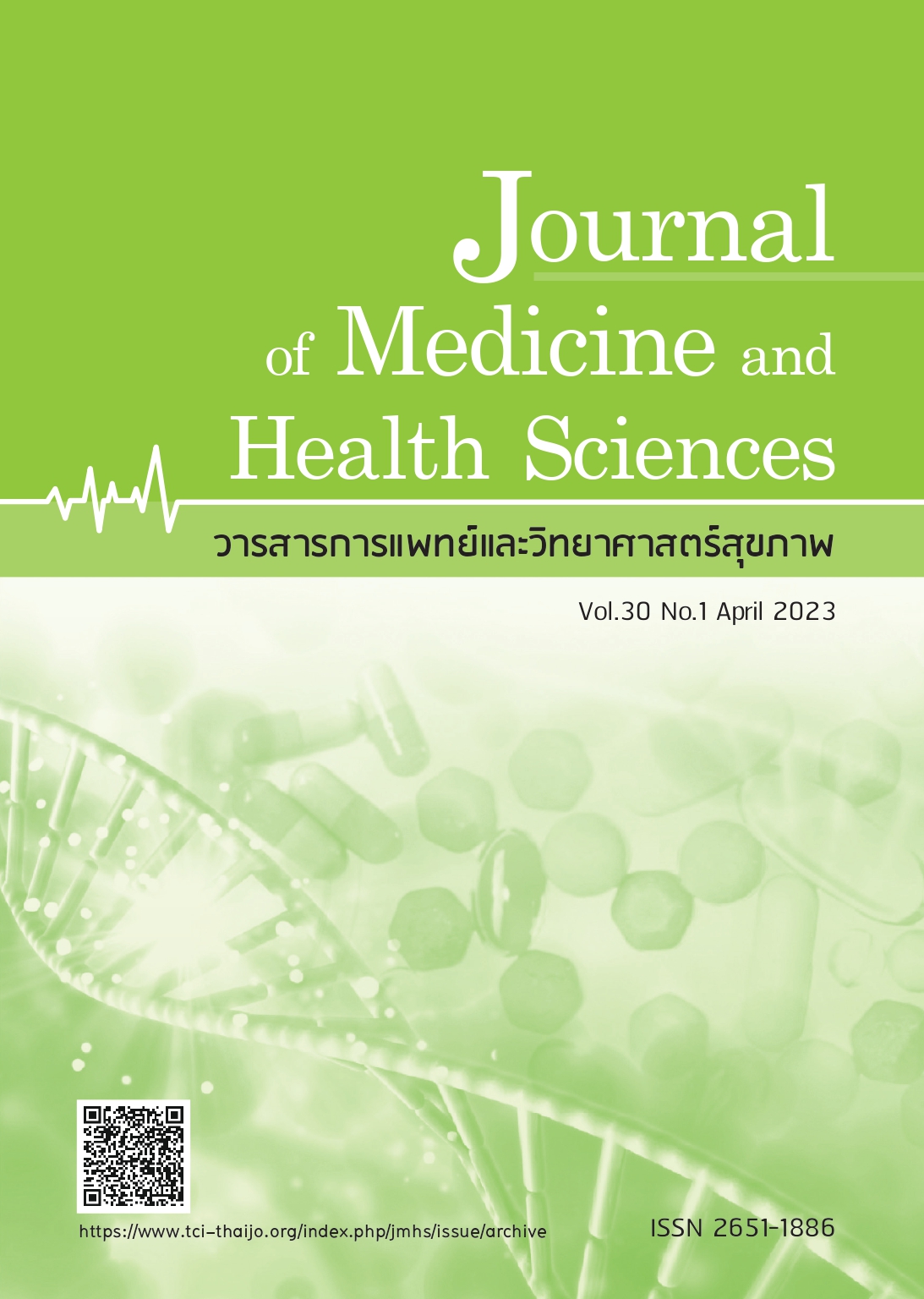A computed tomography assessment of frontal sinus for sex determination in the Thai Population
Keywords:
frontal sinus, computerized tomography, sex, forensic medicineAbstract
The frontal sinus has been used for identification since 1921. It was completed with other parts of bones are destroyed or lost. The aim was to study the parameters of the frontal sinus from computed tomography (CT) to evaluate sex determination. This retrospective study was done at HRH Maha Chakri Sirindhorn Medical Center in Thailand. The 270 subjects for CTs were randomly selected and included 135 men and 135 women. These variables were studied: the absence of frontal sinus, scalloping, complete septum length, incomplete septum length, maximum height, maximum width, maximum total width, and maximum AP diameter. The results showed a mean age of 58.83 ± 15.81 years (men: 59.98 ± 15.01 years and women: 57.68 ± 16.56 years) and five variables that statistically differed (left maximum height, left maximum width, right AP diameter, left AP diameter, and total maximum width). The ROC curve was analyzed at a cutoff point for each variable. The accuracy percentage was in the range of 56.47 - 74.90. The use of frontal sinus CT scans is another way of conducting sex determination in the Thai population. The frontal sinus configuration study will be helpful for further identification.
References
Missing Person Organization. Announce
for unknown death person 2020 [Available
from: https://missingperson.police.go.th/
corpseAll.php. (accessed 25 May 2022).
Saukko P, Knight B. Knight’s forensic
pathology fourth edition: CRC press; 2015.
Aydınlıoğlu A, Kavaklıı A, Erdem S. Absence
of frontal sinus in Turkish individuals.
Yonsei Med J 2003;44(2):215-8.
Akhlaghi M, Bakhtavar K, Moarefdoost J,
et al. Frontal sinus parameters in computed
tomography and sex determination. Legal
Medicine. 2016;19:22-7.
da Silva RF, Prado FB, Caputo IG, et al. The
forensic importance of frontal sinus
radiographs. J Forensic Leg Med. 2009;16(1):
-23.
Verma K, Nahar P, Singh MP, et al. Use of
frontal sinus and nasal septum pattern as
an aid in personal identification and
determination of gender: A radiographic
study. J Clin Diagn Res. 2017;11(1):Zc71-zc4.
Christensen AM, Hatch GM. Advances in
the use of frontal sinuses for human
identification. New perspectives in
forensic human skeletal identification:
Elsevier; 2018. p. 227-40.
Belaldavar C, Kotrashetti VS, Hallikerimath
SR, et al. Assessment of frontal sinus
dimensions to determine sexual dimorphism
among Indian adults. J Forensic Dent Sci.
;6(1):25-30.
Suman JL, Jaisanghar N, Elangovan S,et
al. Configuration of frontal sinuses: A
forensic perspective. J Pharm Bioallied Sci
;8(Suppl 1):S90-s5.
Kirk NJ, Wood RE, Goldstein M. Skeletal
identification using the frontal sinus
region: A retrospective study of 39 cases.
J Forensic Sci 2002;47(2):318-23.
Thali MJ, Viner MD, Brogdon BG. Brogdon’s
forensic radiology: CRC press; 2010.
Buyuk SK, Karaman A, Yasa Y. Association
between frontal sinus morphology and
craniofacial parameters: A forensic view.
J Forensic Leg Med 2017;49:20-3.
Shireen A, Goel S, Ahmed IM, et al.
Radiomorphometric evaluation of the
frontal sinus in relation to age and gender
in Saudi population. J Int Soc Prev Community
Dent 2019;9(6):584.
Silva RF, Picoli FF, Botelho TL, et al.
Forensic identification of decomposed
human body through comparison between
ante-mortem and post-mortem CT Images
of Frontal Sinuses: Case report. Acta
Stomatol Croat 2017;51(3):227-31.
Sangvichien S, Boonkaew K, Chuncharunee
A, et al. Sex determination in Thai skulls
by using craniometry: multiple logistic
regression analysis. Siriraj Med J 2007;59(5):
-21.
S u j a r i t t h a m S , V i c h a i r a t K ,
Prasitwattanaseree S, et al. Thai human
skeleton sex identification by mastoid
process measurement. Chiang Mai Med J
;50(2):43-50.
Ruenhunsa S, Vachirawongsakorn V.
Cranial thickness in relation to age, gender
and head circumference in Thai
population. Chula Med J 2022;66:337-42.
Rooppakhun S, Piyasin S, Vatanapatimakul
N, et al. Craniometric study of Thai skull
based on three-dimensional computed
tomography (CT) data. J Med Assoc Thai
;93(1):90.
Harris A, Wood R, Nortje C, et al. Gender
and ethnic differences of the radiographic
image of the frontal region. J Forensic
Odontostomatol 1987;5(2):51-7.
Soman BA, Sujatha GP, Lingappa A.
Morphometric evaluation of the frontal
sinus in relation to age and gender in
subjects residing in Davangere, Karnataka.
J Forensic Dent Sci 2016;8(1):57.
Tang J-P, Hu D-Y, Jiang F-H, et al. Assessing
forensic applications of the frontal sinus
in a Chinese Han population. Forensic Sci
Int 2009;183(1-3):104.e1- e3.
Koertvelyessy T. Relationships between
the frontal sinus and climatic conditions:
a skeletal approach to cold adaptation.
Am J Phys Anthropol 1972;37(2):161-72.
Hanson CL, Owsley DW. Frontal sinus size
in Eskimo populations. Am J Phys
Anthropol. 1980;53(2):251-5.
Ve r m a S , M a h i m a V , P a t i l K .
Radiomorphometric analysis of frontal
sinus for sex determination. J Forensic
Dent Sci 2014;6(3):177.
Downloads
Published
How to Cite
Issue
Section
License

This work is licensed under a Creative Commons Attribution-NonCommercial-NoDerivatives 4.0 International License.



